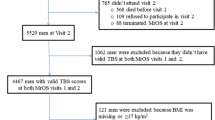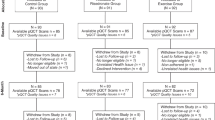Abstract
Summary
Weight loss in men in late life was associated with lower bone strength. In contrast, weight gain was not associated with a commensurate increase in bone strength. Future studies should measure concurrent changes in weight and parameters of bone strength and microarchitecture and evaluate potential causal pathways underlying these associations.
Introduction
Our aim was to determine associations of weight loss with bone strength and microarchitecture.
Methods
We used data from 1723 community-dwelling men (mean age 84.5 years) who attended the MrOS study Year (Y) 14 exam and had high-resolution peripheral quantitative computed tomography (HR-pQCT) scans at ≥ 1 skeletal sites (distal tibia, distal radius, or diaphyseal tibia). Weight change from Y7 to Y14 exams (mean 7.3 years between exams) was classified as moderate weight loss (loss ≥ 10%), mild weight loss (loss 5 to < 10%), stable weight (< 5% change), or weight gain (gain ≥ 5%). Mean HR-pQCT parameters (95%CI) were calculated by weight change category using linear regression models adjusted for age, race, site, health status, body mass index, limb length, and physical activity. The primary outcome measure was estimated failure load.
Results
There was a nonlinear association of weight change with failure load at each skeletal site with different associations for weight loss vs. weight gain (p < 0.03). Failure load and total bone mineral density (BMD) at distal sites were lower with greater weight loss with 7.0–7.6% lower failure loads and 4.3–5.8% lower BMDs among men with moderate weight loss compared to those with stable weight (p < 0.01, both comparisons). Cortical, but not trabecular, BMDs at distal sites were lower with greater weight loss. Greater weight loss was associated with lower cortical thickness at all three skeletal sites.
Conclusion
Weight loss in men in late life is associated with lower peripheral bone strength and total BMD with global measures reflecting cortical but not trabecular parameters.


Similar content being viewed by others
References
Dennison E, Eastell R, Fall CH, Kellingray S, Wood PJ, Cooper C (1999) Determinants of bone loss in elderly men and women: a prospective population-based study. Osteoporos Int 10:384–391
Ensrud KE, Ewing SK, Stone KL, Cauley JA, Bowman PJ, Cummings SR (2003) Intentional and unintentional weight loss increase bone loss and hip fracture risk in older women. J Am Geriatr Soc 51:1740–1747
Ensrud KE, Fullman RL, Barrett-Connor E, Cauley JA, Stefanick ML, Fink HA, Lewis CE, Orwoll E (2005) Voluntary weight reduction in older men increases hip bone loss: the osteoporotic fractures in men study. J Clin Endocrinol Metab 90:1998–2004
Hannan MT, Felson DT, Dawson-Hughes B, Tucker KL, Cupples LA, Wilson PW, Kiel DP (2000) Risk factors for longitudinal bone loss in elderly men and women: the Framingham Osteoporosis Study. J Bone Miner Res 15:710–720
Knoke JD, Barrett-Connor E (2003) Weight loss: a determinant of hip bone loss in older men and women. The Rancho Bernardo Study. Am J Epidemiol 158:1132–1138
Patsch JM, Burghardt AJ, Kazakia G, Majumdar S (2011) Noninvasive imaging of bone microarchitecture. Ann N Y Acad Sci 1240:77–87
Liu XS, Zhang XH, Sekhon KK, Adams MF, McMahon DJ, Bilezikian JP, Shane E, Guo XE (2010) High-resolution peripheral quantitative computed tomography can assess microstructural and mechanical properties of human distal tibial bone. J Bone Miner Res 25:746–756
MacNeil JA, Boyd SK (2008) Bone strength at the distal radius can be estimated from high-resolution peripheral quantitative computed tomography and the finite element method. Bone 42:1203–1213
Yu EW, Bouxsein ML, Putman MS, Monis EL, Roy AE, Pratt JS, Butsch WS, Finkelstein JS (2015) Two-year changes in bone density after Roux-en-Y gastric bypass surgery. J Clin Endocrinol Metab 100:1452–1459
Orwoll E, Blank JB, Barrett-Connor E, Cauley J, Cummings S, Ensrud K, Lewis C, Cawthon PM, Marcus R, Marshall LM, McGowan J, Phipps K, Sherman S, Stefanick ML, Stone K (2005) Design and baseline characteristics of the osteoporotic fractures in men (MrOS) study—a large observational study of the determinants of fracture in older men. Contemp Clin Trials 26:569–585
Blank JB, Cawthon PM, Carrion-Petersen ML, Harper L, Johnson JP, Mitson E, Delay RR (2005) Overview of recruitment for the Osteoporotic Fractures in Men study (MrOS). Contemp Clin Trials 26:557–568
Ensrud KE, Harrison SL, Cauley JA, Langsetmo L, Schousboe JT, Kado DM, Gourlay ML, Lyons JG, Fredman L, Napoli N, Crandall CJ, Lewis CE, Orwoll ES, Stefanick ML, Cawthon PM (2017) Impact of competing risk of mortality on association of weight loss with risk of central body fractures in older men: a prospective cohort study. J Bone Miner Res 32:624–632
Newman AB, Yanez D, Harris T, Duxbury A, Enright PL, Fried LP (2001) Weight change in old age and its association with mortality. J Am Geriatr Soc 49:1309–1318
Bonaretti S, Vilayphiou N, Chan CM, Yu A, Nishiyama K, Liu D, Boutroy S, Ghasem-Zadeh A, Boyd SK, Chapurlat R, McKay H, Shane E, Bouxsein ML, Black DM, Majumdar S, Orwoll ES, Lang TF, Khosla S, Burghardt AJ (2017) Operator variability in scan positioning is a major component of HR-pQCT precision error and is reduced by standardized training. Osteoporos Int 28:245–257
Bonaretti S, Majumdar S, Lang TF, Khosla S, Burghardt AJ (2017) The comparability of HR-pQCT bone measurements is improved by scanning anatomically standardized regions. Osteoporos Int 28:2115–2128
Burghardt AJ, Pialat JB, Kazakia GJ, Boutroy S, Engelke K, Patsch JM, Valentinitsch A, Liu D, Szabo E, Bogado CE, Zanchetta MB, McKay HA, Shane E, Boyd SK, Bouxsein ML, Chapurlat R, Khosla S, Majumdar S (2013) Multicenter precision of cortical and trabecular bone quality measures assessed by high-resolution peripheral quantitative computed tomography. J Bone Miner Res 28:524–536
Pialat JB, Burghardt AJ, Sode M, Link TM, Majumdar S (2012) Visual grading of motion induced image degradation in high resolution peripheral computed tomography: impact of image quality on measures of bone density and micro-architecture. Bone 50:111–118
Burghardt AJ, Buie HR, Laib A, Majumdar S, Boyd SK (2010) Reproducibility of direct quantitative measures of cortical bone microarchitecture of the distal radius and tibia by HR-pQCT. Bone 47:519–528
Hildebrand T, Laib A, Muller R, Dequeker J, Ruegsegger P (1999) Direct three-dimensional morphometric analysis of human cancellous bone: microstructural data from spine, femur, iliac crest, and calcaneus. J Bone Miner Res 14:1167–1174
Manske SL, Zhu Y, Sandino C, Boyd SK (2015) Human trabecular bone microarchitecture can be assessed independently of density with second generation HR-pQCT. Bone 79:213–221
Mueller TL, Christen D, Sandercott S, Boyd SK, van RB, Eckstein F, Lochmuller EM, Muller R, van Lenthe GH (2011) Computational finite element bone mechanics accurately predicts mechanical competence in the human radius of an elderly population. Bone 48:1232–1238
MacNeil JA, Boyd SK (2007) Load distribution and the predictive power of morphological indices in the distal radius and tibia by high resolution peripheral quantitative computed tomography. Bone 41:129–137
Washburn RA, Smith KW, Jette AM, Janney CA (1993) The Physical Activity Scale for the Elderly (PASE): development and evaluation. J Clin Epidemiol 46:153–162
Cohen J (1988) Statistical power analysis for the behavioral sciences, 2nd edn. Hillsdale, L. Erlbaum Associates
Williamson DF, Kahn HS, Remington PL, Anda RF (1990) The 10-year incidence of overweight and major weight gain in US adults. Arch Intern Med 150:665–672
Crandall CJ, Hovey KM, Cauley JA, Andrews CA, Curtis JR, Wactawski-Wende J, Wright NC, Li W, LeBoff MS (2015) Wrist fracture and risk of subsequent fracture: findings from the Women’s Health Initiative study. J Bone Miner Res 30:2086–2095
Schafer AL (2016) Decline in bone mass during weight loss: a cause for concern? J Bone Miner Res 31:36–39
Lee CG, Boyko EJ, Nielson CM, Stefanick ML, Bauer DC, Hoffman AR, Dam TT, Lapidus JA, Cawthon PM, Ensrud KE, Orwoll ES (2011) Mortality risk in older men associated with changes in weight, lean mass, and fat mass. J Am Geriatr Soc 59:233–240
Sornay-Rendu E, Boutroy S, Vilayphiou N, Claustrat B, Chapurlat RD (2013) In obese postmenopausal women, bone microarchitecture and strength are not commensurate to greater body weight: the Os des Femmes de Lyon (OFELY) study. J Bone Miner Res 28:1679–1687
Samelson, E., Kiel, D., Broe, K., Xu, H., Yang, L., McLean, R., Sahni, S., Hannan, M., Bouxsein, M., Liu, C-T. (2017) Adverse effects of weight loss on bone microarchitecture in obese and non-obese older adults: the Framingham Study. J Bone Miner Res 32 (Suppl 1). Available at http://www.asbmr.org/education/AbstractDetail?aid=896de97f-5da8-4680-978e-1e170f9e0b6c. Accessed 10-24-2017
Burt LA, Hanley DA, Boyd SK (2017) Cross-sectional versus longitudinal change in a prospective HR-pQCT study. J Bone Miner Res 32:1505–1513
Shanbhogue VV, Brixen K, Hansen S (2016) Age- and sex-related changes in bone microarchitecture and estimated strength: a three-year prospective study using HRpQCT. J Bone Miner Res 31:1541–1549
Cooper DM, Kawalilak CE, Harrison K, Johnston BD, Johnston JD (2016) Cortical bone porosity: what is it, why is it important, and how can we detect it? Curr Osteoporos Rep 14:187–198
Acknowledgments
The Osteoporotic Fractures in Men (MrOS) Study is supported by the National Institutes of Health funding. The following institutes provide support: the National Institute on Aging (NIA), the National Institute of Arthritis and Musculoskeletal and Skin Diseases (NIAMS), the National Center for Advancing Translational Sciences (NCATS), and NIH Roadmap for Medical Research under the following grant numbers: U01 AG027810, U01 AG042124, U01 AG042139, U01 AG042140, U01 AG042143, U01 AG042145, U01 AG042168, U01 AR066160, and UL1 TR000128. A.J. Burghardt received additional support through grant number R01 AR060700.
This manuscript is the result of work supported with resources and use of facilities of the Minneapolis VA Health Care System. The contents do not represent the views of the US Department of Veterans Affairs or the US Government.
Author information
Authors and Affiliations
Consortia
Corresponding author
Ethics declarations
The institutional review board at each participating institution approved the study protocol and written informed consent was obtained from all participants.
Conflicts of interest
None.
Rights and permissions
About this article
Cite this article
Ensrud, K.E., Vo, T.N., Burghardt, A.J. et al. Weight loss in men in late life and bone strength and microarchitecture: a prospective study. Osteoporos Int 29, 1549–1558 (2018). https://doi.org/10.1007/s00198-018-4489-6
Received:
Accepted:
Published:
Issue Date:
DOI: https://doi.org/10.1007/s00198-018-4489-6




